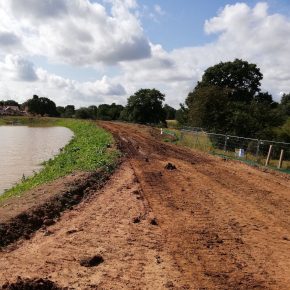
GUEST ARTICLE: Housebuilding and water treatment – what you need to know
This guest article sees Tristan Hughes, Sales Manager at wastewater treatment specialist, Siltbuster, discuss the issues and considerations surrounding the management of excess water on new build sites.
“There are plenty of mitigation measures that can be implemented prior to any work commencing on new build sites. Just like detailed risk assessments have been carried out to support safe methods of working during COVID-19, they should also be carried out with respect to the management of excess water to ensure ‘Zero Harm’ to the environment.
It is important that housebuilders get this right, not least because the sentencing guidelines are very strict. Historic cases have seen housebuilders face fines of £120,000 for releasing silty, polluting water into a watercourse, even after evidence had been presented that this occurred after a period of intense rainfall.
The management of water shouldn’t start only when construction works commence. Instead, it should be considered in detail early on, at the planning stage.
Pertinent information from the ground investigation reports, such as the composition of the near-surface geology, and the location of contaminated groundwater regimes – hydrocarbons, metals etc. – plus protection zones, can all be reviewed at the onset of any project, and site-specific plans can then be made.

The way in which groundworks packages are put together at tender stage can also be reviewed. For instance, the removal of topsoil strips can be phased, rather than a massive area being disturbed at once.
This would reduce the quantity of unprotected ground, often the source of pollution incidents.
The good news for the industry is that practices are changing and ‘as built’ drainage schemes are often being constructed at the start of construction works.
This is absolutely the right thing to be happening. “As built” drainage schemes tend to include swales or attenuation lagoons with hydro-break details to reduce the long term hydrological impacts of the new housing development.
These features can be put to good use during the construction works, forming large areas of attenuation for surface water run-off, safeguarding it from being released, untreated, into the environment.
The lagoons and swales provide the ideal location for a modular water treatment system to be installed alongside. Such systems are tasked with treating silt laden waters, so that it can be discharged, safely and compliantly, to the environment.
Getting a water management strategy wrong on a build site is no longer something that can be absorbed in the build cost. It has the potential to do significant damage to both profit margins and brand reputation.
In addition, a pollution incident has the potential to impede a housebuilder from acquiring new development sites.”
Latest news

30th April 2025
Digital Construction Week announces seminar programme for its landmark 10th edition
Digital Construction Week (DCW) returns to ExCeL London on 4 – 5 June 2025 with its most impactful programme yet. It brings together the best and brightest from across AECO, for two days of practical learning and idea sharing.
Posted in Articles, Building Industry Events, Building Industry News, Building Products & Structures, Building Services, Building Systems, Exhibitions and Conferences, Information Technology, news, Restoration & Refurbishment, Retrofit & Renovation, Seminars
29th April 2025
Senior pledges to ‘bee’ part of the solution with new biodiversity initiative
Senior Architectural Systems has installed its first on-site beehive, marking another step forward in its commitment to sustainability and biodiversity.
Posted in Articles, Building Industry News, Building Products & Structures, Building Services, Curtain Walling, Doors, Glass, Glazing, Innovations & New Products, news, Restoration & Refurbishment, Retrofit & Renovation, Sustainability & Energy Efficiency, Walls, Windows
29th April 2025
West Fraser range delivering key benefits for South-East carpentry company
An experienced carpenter and building site manager who has recently set up his own company is using high performance panel products from the West Fraser range.
Posted in Articles, Building Industry News, Building Products & Structures, Building Systems, Case Studies, Garden, Restoration & Refurbishment, Retrofit & Renovation, Sustainability & Energy Efficiency, Timber Buildings and Timber Products
29th April 2025
CPD Courses Available Online From Ecological Building Systems
Ecological Building Systems, a leading supplier of natural building products for sustainable construction, has revealed its comprehensive CPD programme for the year ahead.
Posted in Articles, Building Industry Events, Building Industry News, Building Products & Structures, Building Services, Continuing Professional Development (CPD's), Information Technology, Innovations & New Products, Insulation, Restoration & Refurbishment, Retrofit & Renovation, Seminars, Sustainability & Energy Efficiency, Training, Walls, Waste Management & Recycling
 Sign up:
Sign up: